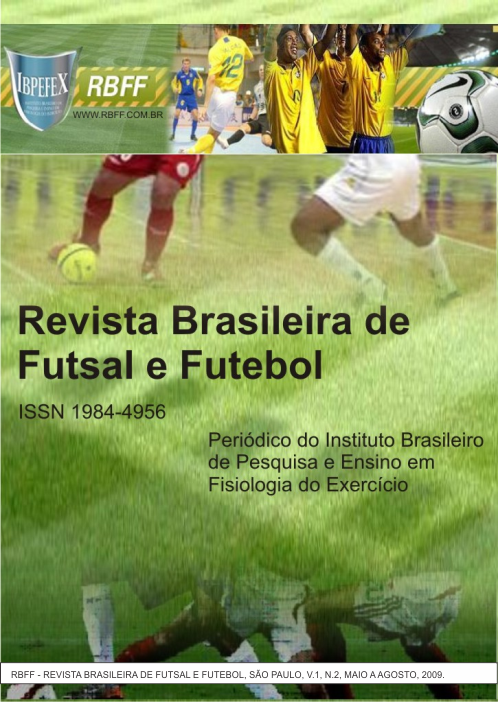The influence of futsal on eye-pedal coordination in schoolchildren aged 8 to 10 years
Abstract
This paper deals with the assessment method futsal players in school and not practicing this method, for the improvement of eye-foot coordination. To measure whether the futsal can assist in the improvement of eye-foot coordination. The history of futsal starting in the decade of thirty. The importance of indoor soccer school in the educational context. The psychomotricity and motor development in physical education classes. We identified two groups of students, regularly enrolled in the College St. Louis, aged between eight and ten years, and the group 1 formed by students of futsal players for at least eighteen months in this institution and group 2, formed by students that only attend the classes of physical education. As the procedure was applied to test for overall praxia-foot-eye coordination. The material used was: sulfite paper, ballpoint pen, a tennis ball, a chair, a tape measure, clipboard and a camera camcorder. Forty-twenty students practicing futsal and twenty students from non-practitioners futsal, which are a result of significant improvement in eye-foot coordination in practitioners of futsal. Recognize the importance of sport as an aid in the coordination of the child and to promote futsal in school for the development of the student as a whole and not aimed at the competition. The indoor soccer is undoubtedly an important tool to improve motor performance of children in school.
References
- Andrade Junior, J. R; Futsal – Aquisição, Iniciação e Especialização. Curitiba. Juruá. p. 33 – 37. 2007.
- Cezário, A. E. S; Influência da atividade física no desenvolvimento motor e rendimento escolar em crianças do Fundamental. 2008. p.10. http://www.boletimef.org/?canal=12&file=1740 acessado em 14/04/2008. 3- Fonseca, V; Bateria Psicomotora (BPM). 2002. http://www.bibliotecauniversia.net/html-bura/ficha/params/id/3277223/html acessado em 28/03/2008.
- Fonseca, V; Psicomotricidade – Perspectivas Multidisciplinares. São Paulo. Artmed. 2004. p.10 – 12; 32 – 34.
- Fonseca, V; Martin, R; Licenciatura em Reabilitação Psicomotora – Programa de Disciplina de Psicomotricidade II. http://www.fmhoutl/estruturtainterna/pdf/pro_03/programa%20pm20II.pdf acessado em 05/04/2008.
- Le Bouch, J; O Desenvolvimento Psicomotor do nascimento até 6 anos. Porto Alegre. Artes Médicas. 1992. p. 150.
- Lomêu, L. M; Histórico do Futsal. 2007. p. 1 – 3. http://www.educacaofisica.org/joomla/index.php?option=com_content&task=view&id=113. acessado em 10/04/2008.
- Meur, A. D; Staes, L; Psicomotricidade – Educação e Reeducação. São Paulo. Manole. 1991.
- Oliveira Neto, P. C; O Perfil dos Escolares da Educação Infantil praticante de Capoeira, em relação às variáveis psicomotoras. 2007. p.18,37, 44 e 45. http://www.revistaseletronicas.pucrs.campus2/-brandt/ef_III_178-4_lutas.pdf acessado em 15/05/2008.
- Marques Neto, N. K.; Silva, V. F. O Efeito do Treino de Visão Periférica na Zona dos Gols do Futsal: Treino da Visão Periférica. Revista de Educação Física. Rio de Janeiro. Vol. 143. p. 18 a 27. 2008
- Rocha, R. A.; Carvalho, H. A. L.; Mesa, F. T.; Mesquita, A. S. Navarro, A. C. O Treinamento da Velocidade de Reação para Goleiros de Futsal. In: Navarro, A. C.; Almeida, R. Futsal. Phorte. São Paulo. p. 111-125.
- Rezer, R; Saad, M. A; Futebol e Futsal: possibilidades e limitações da prática pedagógica em escolinhas. Chapecó. Argos. 2005. p. 27 – 33.
- Santana, W. C; Contextualização Histórica do Futsal. p. 1 – 4. http://www.pedagogiadofutsal.com.br/historia.asp acessado em 18/05/2008.
- Santana, W. C; Os objetivos do Futsal na Infância. p. 1 – 3. http://www.pedagogiadofutsal.com.br/texto_031.asp acessado em 18/05/2008.
- Silva, N. A; O Futsal na Área Escolar. p. 3 – 6. http://www.webartigos.com/articles/3828/1/o-futsal-na-area-escolar/pagina1/html acessado em 02/05/2008.
- Futsal Brasil: O Portal do Futsal Mundial. História do Futsal no Brasil. http://www.futsalbrasil.com.br/historia.php acessado em 25/05/2008
Authors who publish in this journal agree to the following terms:
- Authors retain the copyright and grant the journal the right of first publication, with work simultaneously licensed under the Creative Commons Attribution License BY-NC which allows the sharing of the work with acknowledgment of the authorship of the work and initial publication in this journal.
- Authors are authorized to enter into additional contracts separately for non-exclusive distribution of the version of the work published in this journal (eg, publishing in institutional repository or book chapter), with acknowledgment of authorship and initial publication in this journal.
- Authors are allowed and encouraged to post and distribute their work online (eg, in institutional repositories or on their personal page) at any point before or during the editorial process, as this can bring about productive change as well as increase impact and impact. citation of published work (See The Effect of Free Access).





